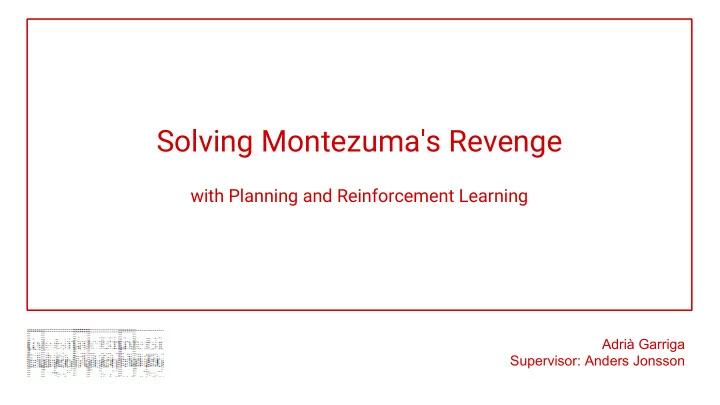

Solving Montezuma's Revenge with Planning and Reinforcement Learning Adrià Garriga Supervisor: Anders Jonsson
Introduction: Why Montezuma’s Revenge? Sparse rewards. > 6 s > 60 actions 1/8 60 < 10 -55 (branching factor = 8)
Introduction: The game. Learning state of the art: 3439 score (Bellemare et. al., 2016) Planning state of the art: 540 score (Lipovetzky, Ramirez and Geffner, 2015)
Reverse Engineering: known memory layout Room X Y Lives Inventory Doors open Jump frame Fall frame 0xff on ground Starts at 0 0x13 on jump start Character loses life if >= 8 http://problemkaputt.de/2k6specs.htm
Planning: Iterated Width - IW( n ): BrFS, pruning when no new tuples of size n . That is, novelty ≤ n - IW(1) combined with greedy BestFS: 540 score Visited positions during IW(1) search (Lipovetzky, Ramirez and Geffner, 2015)
Planning: Iterated Width - Full IW(3): 10 9 possibilities if RAM vector of booleans - 3 · 10 14 possibilities if RAM vector of bytes - - Solution: - IW(3) only on position (room, X, Y) - Give less priority to loss-of-life nodes - Obstacle passing - 1 reward for visiting new room - Randomly prune screens and keep the action sequence with best return Visited positions during position-IW(3) search
Obstacle passing algorithm
Search starts
Life is lost after non-jump action
Go back 1 NOOP 1
Go back 2 NOOP 2
Go back 3 NOOP 3
Go back 4 NOOP 4 [...]
Go back 7 NOOP 7
Keep testing if obstacle is passable Left. Dead? - Yes: back, NOOP - No: continue search
Continue search
Not infallible
Random screen pruning - The trajectory with highest return is kept after each search
Visited spots every search step Score = 11200 p r = 0 Iteration number Search start locations 1 2 3 4 5 6 7 8 9 10 11 12 13
Visited spots every search step Score = 14900 p r = 0.2 Iteration number Search start locations 1 2 3 4 5 6 7 8 9 10 11 12 13
The forbidden portals - Only 4 keys - Need 2 keys in the end - Attach -10000 reward to opening those doors
Planning video
Learning: Tabular Sarsa 51 · 2 · 256 · 256 · 2 · 2 = 26 738 688 possible states 26 738 688 · 8 = 213 909 504 action-state pairs Q with 32-bit float: 213 909 504 · 4 / 10 6 ≈ 855 MB
Shaping: Alleviate sparse rewards - Add rewards to guide the agent in learning - But shaping may make the agent follow a policy that is not optimal in the original setting - Solution: potential-based shaping function (Ng, Harada, and Russell, 1999). F (s, a, s’) = γ · φ(s’) − φ(s) Undesirable shortcuts learned when the shaping is collectable reward “pills”. The agent collects all previous pills when touching one.
Shaping: Alleviate sparse rewards Before having the key After having the key The φ function for the 1st (and only) screen. Yellow is 2, deep purple is 1. The function is 1 when falling to lose a life, RAM(0xD8) >= 8 If all φ is positive, reward for staying still is negative: γ · φ(s) − φ(s) < 0 iff γ < 1, φ(s) > 0
Learning: without options γ = 0.995 frame_skip = 4 ε = 0.1 Annealed ε = 0.7 to 0.1 over 20k episodes Environment reward Environment reward Reward including shaping Reward including shaping x: Thousands of episodes y: Accumulated reward at the end of each episode, mean every 1000 episodes
Learning: with options γ = 0.9995 frame_skip = 1 Annealed ε = 0.7 to 0.1 over 60k episodes Annealed ε = 0.7 to 0.1 over 6k episodes Environment reward Environment reward Reward including shaping Reward including shaping x: Thousands of episodes y: Accumulated reward at the end of each episode, mean every 1000 episodes
Learning video (without options)
Conclusions - Planning - Learning - Domain knowledge is very useful - Reward shaping helps with sparse rewards - Make sure to explore the world enough - Options may do more harm than help. - Our approach is too specific to really be useful
Future Work - Planning - Generalise approach to similar domains (such as Private Eye) - Use trial and error, or controllable pixels, number of pixels changed, … to figure out the “chosen tuple” - Use autoencoder, dimensionality reduction to calculate novelty (Oh et. al., 2015) - Plan using predicted future frames (Oh et. al., 2015) - Learn a high-level representation of the screen map, with synthetic maps - Learning - Use training frames gathered while planning to learn (Guo et. al, 2014)
References Bellemare, M. G. et al. (2013). “The Arcade Learning Environment: An Evaluation Platform for General Agents”. In: Journal of Artificial Intelligence Research 47, pp. 253–279. Bellemare, Marc G et al. (2016). “Unifying Count-Based Exploration and Intrinsic Motivation”. In: arXiv preprint arXiv:1606.01868. Guo X, Singh S, Lee H, Lewis RL, Wang X (2014). “Deep learning for real-time Atari game play using offline Monte-Carlo tree search planning”. In: Advances in Neural Information Processing Systems, pp. 3338–3346. Lipovetzky, Nir, Miquel Ramirez, and Hector Geffner (2015). “Classical planning with simulators: results on the Atari video games”. In: Proc. International Joint Conference on Artificial Intelligence (IJCAI-15). Ng, Andrew Y, Daishi Harada, and Stuart Russell (1999). “Policy invariance under reward transformations: Theory and application to reward shaping”. In: ICML. Vol. 99, pp. 278–287. Oh, Junhyuk et al. (2015). “Action-conditional video prediction using deep networks in atari games”. In: Advances in Neural Information Processing Systems, pp. 2863–2871.
Learning: with options γ = 0.995 frame_skip = 1 ε = 0.1 Annealed ε = 0.7 to 0.1 over 20k episodes Environment reward Environment reward Reward including shaping Reward including shaping “Usable” but inefficient options lead to highest return being to jump left x: Thousands of episodes y: Accumulated reward at the end of each episode, mean every 1000 episodes
Recommend
More recommend